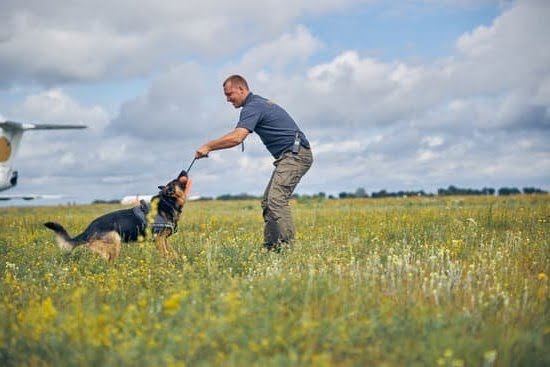Have you ever wondered how to train your dog to stop pulling when walking? It can be frustrating and even a bit embarrassing when our furry companions drag us down the street. In this article, we will explore effective methods for teaching your dog proper leash manners, from understanding their behavior and instincts to using positive reinforcement training techniques.
Understanding Your Dog’s Behavior and Instincts is crucial when it comes to addressing leash pulling. Dogs are natural explorers and scavengers, which means they have a tendency to pull on the leash to investigate their surroundings or follow an interesting scent. This behavior is not necessarily a sign of disobedience, but rather a result of their instincts. By recognizing and understanding these tendencies, we can approach training with empathy and patience.
The Importance of Proper Leash and Collar Usage cannot be overstated. Using the right equipment can make a significant difference in controlling your dog’s pulling behavior.
Whether it’s choosing the appropriate collar or harness for your dog’s size and breed, or learning how to hold the leash properly, these factors play a vital role in successful training. Stay tuned as we delve into positive reinforcement training methods, teaching your dog the heel command, using distractions and redirecting techniques, and more in the following sections of this guide.
The Importance of Proper Leash and Collar Usage
When it comes to training your dog to stop pulling when walking, the importance of proper leash and collar usage cannot be overstated. The leash and collar are essential tools for communicating with your pet and guiding their behavior during walks. Understanding how to use these tools correctly is key in preventing your dog from pulling and lunging while on a walk.
First, it’s important to choose the right leash and collar for your dog. For larger or stronger dogs, a sturdy, well-fitted collar and harness can provide better control. It’s essential to ensure that the collar or harness fits properly and does not cause discomfort to your dog. Additionally, using a standard six-foot leash is recommended as it allows you to maintain control without restricting your dog’s movements too much.
Using the leash and collar effectively is also crucial. It’s important not to yank or pull on the leash when your dog starts to pull as this can cause discomfort or injury. Instead, use gentle but firm pressure on the leash to guide your dog back into position. Pay attention to any signs of discomfort or distress from your pet while using the leash and make adjustments as necessary.
Another crucial aspect of proper leash and collar usage is maintaining a consistent walking pace. When you walk at a steady pace, you communicate calmness and stability which can help reduce pulling behavior in your dog. Consistency in your movements will also help reinforce the idea that you are leading the walk, not them.
| Proper Leash Usage | Collar Usage |
|---|---|
| Choose a sturdy, well-fitted collar/harness | Ensure proper fit; no discomfort |
| Use a standard six-foot leash for control | Avoid yanking or pulling forcefully |
| Maintain consistent walking pace | Communicate calmness and stability through movement |
Positive Reinforcement Training Methods
When it comes to training your dog to stop pulling when walking, positive reinforcement techniques can be highly effective. This involves rewarding your dog for displaying the desired behavior, rather than punishing them for misbehaving. Here are some positive reinforcement methods that you can use when training your pup:
– **Clicker Training**: Using a clicker to mark the exact moment your dog performs the desired behavior, followed by a treat or praise, can help reinforce good walking habits.
– **Treat-Based Rewards**: Using small, easily consumable treats to reward your dog when they walk without pulling on the leash can motivate them to continue behaving this way.
– **Verbal Praise and Affection**: Dogs respond well to verbal praise and affection from their owners. When your furry friend walks calmly by your side, be sure to shower them with praise and pats on the back.
By using these positive reinforcement training methods consistently, you can effectively communicate to your dog what behaviors are desirable. It is important to remain patient and consistent in implementing these techniques in order for them to be effective. Remember, every dog is different, so find what motivates and excites your pup the most and use it as a reward during training sessions.
Teaching Your Dog the Heel Command
When training your dog to stop pulling when walking, one of the most effective methods is teaching them the “heel” command. This command teaches your dog to walk by your side without pulling on the leash. Here are steps to effectively teach your dog the heel command:
1. Start in a quiet, familiar environment: Begin training in a familiar environment where there are minimal distractions for your dog. This can be inside your home or in your backyard.
2. Use treats and positive reinforcement: Hold a treat in your hand and let your dog smell it. Then, hold the treat in your closed fist at waist level on the side where you want your dog to walk. As they follow the treat, give them verbal praise and reward them with the treat when they are walking next to you without pulling.
3. Practice consistently: Consistency is key when teaching the heel command. Practice for short periods each day and gradually increase the duration of the training sessions as your dog becomes more familiar with the command.
By taking these steps and practicing patience and consistency, you can effectively teach your dog the heel command and help them learn to walk calmly without pulling on their leash.
Using Distractions and Redirecting Techniques
When training your dog to stop pulling while walking, using distractions and redirecting techniques can be incredibly helpful in reinforcing positive behavior. Dogs are naturally curious and easily distracted, so utilizing these methods can aid in teaching them to focus on their handler and walk politely on a leash.
Distraction Tools
One effective way to redirect your dog’s attention while walking is by using distraction tools such as toys or treats. Bringing along your dog’s favorite toy or a high-value treat can help keep their focus on you during walks. When your dog starts to pull, use the distraction tool to regain their attention and encourage them to walk calmly by your side.
Redirecting Techniques
In addition to using distraction tools, redirecting techniques can also be beneficial in teaching your dog not to pull on their leash. This involves changing direction or stopping altogether when your dog begins to pull. By doing so, you are communicating that pulling will not get them where they want to go. Always remember to reward and praise your dog when they respond positively to the redirection, reinforcing the desired behavior.
Utilizing these distraction and redirecting techniques during training sessions will help teach your dog to focus on you and walk politely on a leash, ultimately leading to more enjoyable walks for both you and your furry companion.
Patience and Consistency in Training
Consistency Is Key
When it comes to training your dog to stop pulling when walking, patience and consistency are essential. Dogs thrive on routine, so it’s important to be consistent in your approach to training. This means using the same commands, rewards, and techniques each time you go for a walk. If you send your dog mixed signals or don’t reinforce the same behavior consistently, it can confuse them and make training much more difficult.
Set Realistic Expectations
It’s important to remember that training takes time, and every dog learns at their own pace. Patience is crucial when working with your furry friend. Understand that your dog won’t learn the proper walking manners overnight, and there will be setbacks along the way. Having realistic expectations and remaining patient throughout the process will ultimately lead to better results.
Stay Calm and Positive
Dogs are incredibly intuitive animals and can sense their owner’s emotions. If you become frustrated or agitated during training sessions, your dog will pick up on these feelings and may become anxious or stressed themselves. To maintain a positive environment for learning, it’s important for owners to remain calm and composed during training sessions. Celebrate small victories and progress with praise and rewards, but also be patient when correction is needed.
Taking the time to train your dog to stop pulling when walking requires dedication, patience, and consistency. By creating a positive learning environment for your pet and setting realistic expectations for both of you, you can foster a strong bond while ensuring enjoyable walks together in the future.
Tips for Managing Frustration and Setbacks
Training your dog to stop pulling when walking can be a challenging task, and it’s important to be prepared for frustration and setbacks along the way. One of the most important things to remember is to stay patient and consistent in your training approach. Dogs respond well to positive reinforcement, so it’s crucial to maintain a calm and positive attitude during training sessions.
In addition, it’s essential to manage your expectations and understand that progress may not happen overnight. Some dogs may take longer to learn than others, so it’s important not to get discouraged if you don’t see immediate results. By staying patient and consistent, you will eventually see improvement in your dog’s behavior.
Another tip for managing frustration and setbacks is to take breaks when needed. If you find yourself becoming frustrated during a training session, it’s okay to take a step back and regroup. This will allow both you and your dog some time to relax before returning to the training session with a clear mindset.
| Managing Frustration | Dealing With Setbacks |
|---|---|
| Stay patient and consistent | Keep expectations realistic |
| Use positive reinforcement | Take breaks when needed |
| Maintain a calm attitude | Acknowledge progress, no matter how small |
Taking Your Training to Different Environments
When training your dog to stop pulling when walking, it is essential to take your training to different environments. Dogs often become accustomed to certain behaviors in familiar settings, so exposing them to new environments can help reinforce their training. By training in various locations, your dog will learn to generalize the desired behavior and understand that they should walk calmly on a leash no matter where they are.
One effective way to take your training to different environments is by starting in low-distraction areas, such as your backyard or a quiet neighborhood street. Once your dog has mastered walking without pulling in these environments, gradually introduce new and more stimulating locations.
This could include parks, busy streets, or areas with other dogs and people. By slowly acclimating your dog to different environments, you can help them learn to focus on you and remain calm on the leash regardless of the surroundings.
Additionally, when training in different environments, it is important to be patient and consistent with your commands and expectations. Your dog may initially struggle in new settings, but with consistent training and positive reinforcement, they will eventually learn to behave appropriately on the leash. It’s also crucial to continue using distractions and redirecting techniques when necessary, especially in more challenging environments. With time and persistence, your dog will become proficient at walking without pulling in any location you choose.
Seeking Professional Help if Needed
In conclusion, training your dog to stop pulling when walking requires a combination of understanding their behavior, using the right equipment, and employing positive reinforcement techniques. It’s important to recognize that some dogs may require the expertise of a professional trainer or behaviorist to address persistent pulling issues. While many dog owners can successfully train their pets using the methods outlined in this article, there are cases where seeking professional help becomes necessary.
If you find that despite consistent training efforts your dog continues to pull excessively on walks, it may be time to consider enlisting the help of a professional. A qualified trainer or behaviorist can assess your dog’s specific needs and create a personalized training plan tailored to address the pulling behavior. They have the experience and knowledge to identify any underlying reasons for pulling and can provide guidance on how to effectively modify this behavior.
Furthermore, seeking professional help does not signify failure as a dog owner. Instead, it demonstrates dedication towards addressing your pet’s needs and ensuring their well-being. With the assistance of a trained professional, you can work towards achieving successful results in training your dog to walk calmly and politely on a leash. Remember that every dog is different, and what works for one may not work for another – seeking help when needed shows responsible pet ownership.
Frequently Asked Questions
How Do I Stop My Dog From Pulling When I Walk?
There are several ways to stop your dog from pulling when you walk. One effective method is to use positive reinforcement training, such as rewarding your dog with treats when they walk without pulling. Another approach is to use a no-pull harness or head halter, which can help discourage pulling by redirecting your dog’s attention back to you.
How Long Does It Take to Train a Dog to Stop Pulling on Leash?
The time it takes to train a dog to stop pulling on a leash can vary depending on the dog’s breed, age, and temperament, as well as the consistency of the training. Some dogs may make progress in just a few weeks with daily training sessions, while others may take longer.
It’s important for pet owners to be patient and consistent in their training efforts.
What Is the Command for a Dog to Stop Pulling?
The command for a dog to stop pulling is typically “heel” or “close.” When teaching this command, it’s important to use positive reinforcement by rewarding your dog when they respond correctly. Consistent practice and patience are key when training a dog to walk without pulling using verbal commands.

Welcome to the blog! I am a professional dog trainer and have been working with dogs for many years. In this blog, I will be discussing various topics related to dog training, including tips, tricks, and advice. I hope you find this information helpful and informative. Thanks for reading!





